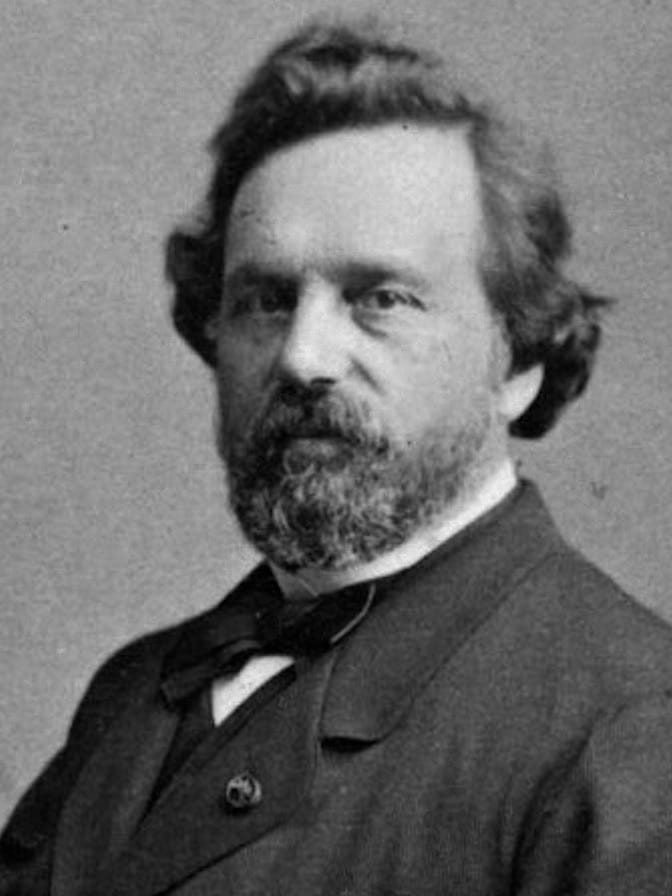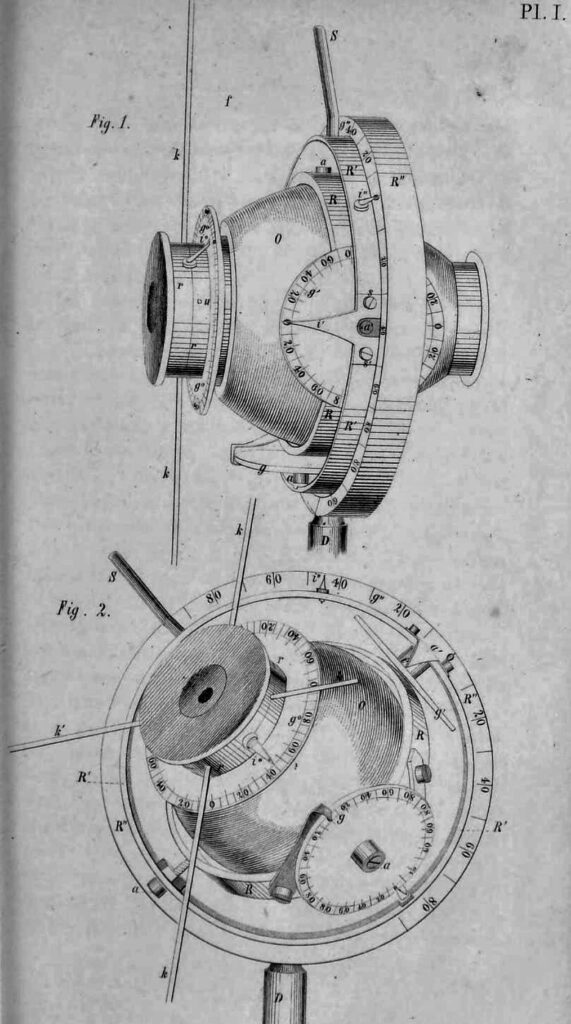Franciscus Donders

Franciscus Cornelis Donders (1818-1889) was a Dutch ophthalmologist and physiologist
Donders pioneering work laid the foundations of modern visual science and experimental psychology. Born in Tilburg, he initially trained as a military physician before earning his MD in 1840. Early in his career, Donders made significant contributions to physiology, emphasizing the law of conservation of energy in living systems.
His most enduring legacy stems from ophthalmology: Donders systematically studied errors of refraction, accommodation, and ocular motility, publishing the landmark monograph On the Anomalies of Accommodation and Refraction of the Eye (1864). He established the concept of the “Reduced Eye” and promoted the use of corrective lenses for refractive errors. Donders also invented instruments such as the ophthalmotrope and the impression tonometer and was instrumental in introducing the ophthalmoscope to Dutch clinical practice.
Beyond ophthalmology, Donders founded mental chronometry, demonstrating that mental operations take measurable time. His subtraction method (1868) became a cornerstone of cognitive psychology and neurophysiology. His philanthropic efforts were notable: he co-founded the Netherlands Hospital for Eye Patients (1858), providing free eye care to the poor.
Donders was a mentor to future leaders of ophthalmology and physiology and maintained influential collaborations with contemporaries such as Hermann von Helmholtz (1821–1894) and Albrecht von Graefe (1828–1870). He remained active in science until his death in Utrecht in 1889.
Biographical Timeline
- 1818 – Born May 27 in Tilburg, North Brabant, Netherlands; youngest of nine children (eight older sisters). His father Jan Francis Donders died shortly after his birth.
- 1825 – Boarding school in Duizel near Eindhoven at age 7; remained six years, serving as a pupil-teacher during the last two years.
- 1831 – Entered Latin School at Boxmeer, graduated cum laude in January 1835.
- 1835 – Entered Military Medical School at Utrecht and simultaneously enrolled in the medical faculty at Utrecht University.
- 1840 – Appointed health officer at Vlissingen; received MD from Leiden University
- 1842 – Promoted to lecturer in anatomy, histology, and physiology at the Utrecht Military Medical School.
- 1844 – Published paper asserting conservation of energy in physiology, stating that animal heat is chemical heat.
- 1845 – Invented the ophthalmotrope (mechanical model to demonstrate eye movements). Married Ernestine Zimmerman (d.1887).
- 1846 – Published works on harmony of animal life and species transformation, anticipating principles later seen in Darwin’s theory.
- 1847 – Appointed Extraordinary Professor at Utrecht University, lecturing on forensic medicine, anthropology, general biology, and ophthalmology.
- 1851 – Visited London Great Exhibition, met Albrecht von Graefe (1828–1870) and William Bowman (1816–1892), learned about Helmholtz’s ophthalmoscope.
- 1858 – Founded the Netherlands Hospital for Necessitous Eye-Patients (Ooglijdersgasthuis) in Utrecht; first eye hospital in the Netherlands.
- 1860 – Introduced cylindrical and prismatic lenses for treatment of astigmatism.
- 1862 – Promoted to Ordinary Professor of Physiology at Utrecht University; invented impression tonometer.
- 1864 – Published landmark book On the Anomalies of Accommodation and Refraction of the Eye; established concept of the “Reduced Eye”.
- 1869 – Met Charles Darwin for the first time; Darwin acknowledged Donders’ early anticipation of natural selection.
- 1870 – Declared all treatment at the Eye Hospital to be free of charge, including medicines, surgery, and optical devices.
- 1889 – Died March 24 in Utrecht, aged 70.
Medical Eponyms
Donders Law (1847)
For any given direction of gaze, the eye assumes a unique torsional position, independent of the path taken to reach it.
The basis for understanding ocular kinematics and extraocular muscle function. Proposed by Donders in 1847, this principle provided the basis for Helmholtz’s Listing’s Law (1866), influencing modern theories of ocular kinematics.
Although the eye could assume an infinite number of torsional positions for any given gaze direction, it is well established that, during visual fixation of a distant target with the head upright, the eye adopts a unique torsional position for each gaze direction.
Donders FC. Beiträge zur Lehre von den Bewegungen des menschlichen Auges. Holländische Beiträge zu den anatomischen und physiologischen Wissenschaften, 1847.
Space of Donders
The three-dimensional movement envelope of the eye within the orbit, bounded by the constraints of Donders Law. Essential in ocular motility studies and modern 3D eye movement modelling. Introduced during his studies of ocular rotations; later formalised in Helmholtz’s Physiological Optics (1867–1871).
Each position of the eye is connected with a determinate condition of torsion, depending only on the direction of the visual line.
von Helmholtz H. Handbuch der Physiologischen Optik. Hamburg: Voss; 1867.
Mental Chronometry (Donders Subtraction Method)
Donders demonstrated that mental processes require measurable time, using three reaction-time paradigms in his article On the Speed of Mental Processes in 1868
- a-method (simple RT) – single stimulus/response
- b-method (choice RT) – stimulus discrimination & response selection
- c-method (go/no-go) – stimulus discrimination without response choice
He computed discrimination and decision times (≈36 ms and 47 ms).
The subtraction method remains fundamental in cognitive neuroscience, influencing ERP and neuroimaging paradigms.
Subtracting the reaction time for the simple task from that of the choice task isolates the duration of decision; mental processes take time.
Donders FC. Over de snelheid van psychische processen. Onderzoekingen gedaan in het Physiologisch Laboratorium der Utrechtsche Hoogeschool, 1868
Donders Ophthalmotrope (1845)
The Phaenophthalmotrop was an instructional device devised by Donders to illustrate ocular movements and the laws governing them including Donders Law and Listing’s Law. Unlike earlier ophthalmotropes, which mainly demonstrated the action of individual eye muscles, the Phaenophthalmotrop focused on visualizing eye positions and torsional changes during combined vertical and horizontal gaze shifts. The instrument consisted of:
- A model eyeball mounted on a system of concentric rings, enabling rotation about horizontal, vertical, and oblique axes.
- Graduated scales and indices to measure angles of elevation, depression, and lateral displacement.
- Thin rods (kk) representing the vertical meridian, which allowed observers to detect and measure torsional tilts when the eye rotated into oblique positions.
- An axis channel with cross-hair alignment for viewing and confirming positions, often combined with afterimage experiments.
Using the device, Donders demonstrated that when the eye moves from the primary to a secondary position, its torsional orientation depends only on elevation and azimuth and not on the path of movement – a principle Helmholtz formalized as Donders Law. The apparatus also allowed demonstration of Helmholtz’s analytical concept of “wheel rotation” and comparison with real eye behaviour.
The Phaenophthalmotrop makes visible the laws discovered by Donders and Listing; every secondary position of the eye can be shown as resulting from a single rotation about an axis perpendicular to both the initial and final directions of the visual line.

Donders Pressure (Physiological Principle)
Historical term describing pressure variations within the eye during accommodation, associated with intraocular fluid dynamics.
Controveries
Donders and Snellen: Mentor and the Birth of Optotypes
Donders was the mentor and senior colleague of Herman Snellen (1834–1908) at the Utrecht Eye Hospital. In the early 1860s, Donders recognized the need for a standardized, reproducible method to measure visual acuity, based on the principle that test objects should subtend a fixed visual angle.
Under Donders’ direction, Snellen developed his optotypes, isolated capital letters designed to subtend 5 minutes of arc at a specified distance. This innovation was presented by Donders at the Second International Congress of Ophthalmology in Paris (1862), gaining international attention. The Snellen chart quickly became the first widely accepted visual acuity standard.
At the time, Eduard Jaeger (1818-1884) and his continuous-text “Schrift-Scalen” dominated reading vision tests. Donders and Snellen championed optotypes for their precision and ability to assign numerical values to acuity, in contrast to Jaeger’s qualitative approach.
Major Publications
- Donders FC. Over de beweeging van het menschelijk oog. Utrecht, 1845
- Donders FC. Beiträge zur Lehre von den Bewegungen des menschlichen Auges. Holländische Beiträge zu den anatomischen und physiologischen Wissenschaften, 1847. [Donders Law]
- Donders FC. Beiträge zur physiologischen Optik. Leipzig, 1857
- Donders FC. On the anomalies of accommodation and refraction of the eye, witha preliminary essay on physiological dioptrics. 1864
- Donders FC. Over de snelheid van psychische processen [On the speed of psychical processes]. Onderzoekingen gedaan in het Physiologisch Laboratorium der Utrechtsche Hoogeschool, 1868–1869; 2: 92–120.
- Donders FC. Elfde jaarlijksch verslag betrekkelijk de verpleging en het onderwijs in het Nederlandsch Gasthuis voor ooglijders [The 11th yearly report of the Netherlands Hospital for Necessitous Eye Patients]. Van de Weijer PW; Utrecht, the Netherlands: 1870. 1–195
- Donders FC. Die Bewegungen des Auges, veranschaulicht durch das phaenophthalmotrop. Archiv für Ophthalmologie. 1870; 16: 54–175.
- Donders FC. Albrecht von Graefe und die Ueberreichung der Graefe-Medaille an Hermann von Helmholtz. 1886
- Donders FC. An essay on the nature and the consequences of anomalies of refraction. [Revised and edited by Charles A Oliver] 1899
References
Biography
- Frans Cornelis Donders, 1818-1889. 1891
- ten Diesscate G. De persoonlijkheid van Franciscus Cornelis Donders [The personality of Franciscus Cornelis Donders]. Ned Tijdschr Geneeskd. 1951 Nov 17;95(46):3421-41.
- Duke-Elder S. Franciscus Cornelis Donders. Br J Ophthalmol. 1959 Feb;43(2):65-8.
- van Gijn J, Gijselhart JP. Donders: oogarts en fysioloog [Franciscus Donders (1818-1889): ophthalmologist and physiologist]. Ned Tijdschr Geneeskd. 2011;155:A1979.
- Roper-Hall G. Franciscus Cornelis Donders (1818-1889): Dutch biologist, physiologist, and ophthalmologist. Am Orthopt J. 2012;62:99-106.
- Timoney PJ, Breathnach CS. Franciscus Cornelis Donders (1818-1889). Ir J Med Sci. 2015 Sep;184(3):573-5.
- Van Opstal AJ. 200 years Franciscus Cornelis Donders. Strabismus. 2018;26(4):159-162.
- Desk of Dr. Franciscus (or Frans) Cornelis Donders. Vagelos College of Physicians and Surgeons
- Biography F.C. Donders. Donders Institute
Eponymous terms
- Donders FC. On the speed of mental processes. Acta Psychol (Amst). 1969;30:412-31.
- Schmidgen H. Of frogs and men: the origins of psychophysiological time experiments, 1850-1865. Endeavour. 2002 Dec;26(4):142-8.
- Wade NJ. Pioneers of eye movement research. Iperception. 2010;1(2):33-68.
- Vidal F, Burle B, Grapperon J, Hasbroucq T. An ERP study of cognitive architecture and the insertion of mental processes: Donders revisited. Psychophysiology. 2011 Sep;48(9):1242-51
- Thurtell MJ, Joshi AC, Walker MF. Three-dimensional kinematics of saccadic and pursuit eye movements in humans: relationship between Donders’ and Listing’s laws. Vision Res. 2012 May 1;60:7-15.
- Roelofs A. One hundred fifty years after Donders: Insights from unpublished data, a replication, and modeling of his reaction times. Acta Psychol (Amst). 2018 Nov;191:228-233.
Eponym
the person behind the name
BA MA (Oxon) MBChB (Edin) FACEM FFSEM. Emergency physician, Sir Charles Gairdner Hospital. Passion for rugby; medical history; medical education; and asynchronous learning #FOAMed evangelist. Co-founder and CTO of Life in the Fast lane | On Call: Principles and Protocol 4e| Eponyms | Books |
